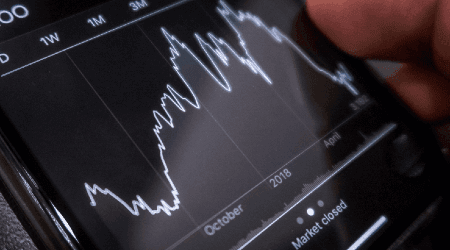Our investment account pick: J.P. Morgan Personal Advisors
- Expert-built portfolios matched to your goals
- Personalized financial planning
Exchange-traded funds (ETFs) and mutual funds both hold a basket of stocks, bonds, currencies or commodities. Because of that, they can instantly diversify your holdings through a single investment. This can be ideal for retirement and hands-off investors who want to avoid picking stocks or other assets themselves.
| ETF | Mutual fund | |
|---|---|---|
How ETFs and mutual funds are managed: active or passive | ETFs are typically passive funds, meaning there’s little management over their investments. They automatically track an index — like the S&P 500 or Nasdaq 100 — and the performance closely matches the index. There are actively managed funds, such as Cathie Wood’s ARK funds where they actively buy and sell stocks to try and outperform the S&P 500. | Mutual funds are known for being actively managed, even though some are passively managed, meaning they track an index as an ETF would. Actively managed mutual funds can cost slightly more to own than ETFs because they require people to make those decisions and execute them. |
How they’re traded | ETFs are traded on exchanges. This means you can buy or sell them as you would any other stock on the market, during a trading session at the current price. This gives you greater flexibility, and you can use almost any broker or trading platform to buy ETFs. | Mutual funds are traded and priced at the end of each trading day. Typically, large and established brokerages like Vanguard and Interactive Brokers offer mutual funds, while newer trading platforms like Webull and Robinhood don’t. |
How much they cost | ETFs often have low or no buy fees. Most brokers these days, including SoFi® and Robinhood, offer $0 commission on ETF trades. What’s more, ETFs often have a lower expense ratio — i.e. an annual fee to own the fund — of less than 0.4% on average. That’s $4 each year for every $1,000 invested. However, most index ETFs, such as the S&P 500 ETF cost around 0.03% or $0.3 for every $1,000 invested. | Depending on the broker and the mutual fund, it can cost you up to $50 to buy the fund. Some brokers offer numerous mutual funds without any fees. As for the expense ratio, expect to pay slightly more for a mutual fund — between 0.5% and 1% on average. This fee is between $5 and $10 each year for every $1,000 you invest. However, S&P 500 mutual funds also have a low expense ratio, of around 0.04% or $0.4 for every $1,000 invested. |
How much you need to invest | With ETFs, you can start investing with any amount. In the past, you had to invest enough money to buy at least one share of an ETF. But with many brokers offering fractional shares, you can buy a fraction of an ETF share for as little as $1. | Mutual funds come with specific minimums. For example, to invest in some Vanguard mutual funds, you need to invest at least $3,000. Other funds have lower requirements of at least $1,000. |
How they’re taxed | ETFs are usually more tax-efficient than mutual funds. Basically, you won’t pay capital gains taxes unless you sell your ETF shares for a profit. If you hold ETFs in an individual account, this can have a huge impact in the long run. But it won’t make a difference with tax-advantaged accounts like IRAs or 401(k). | Mutual funds tend to incur higher capital gains taxes. That’s because they’re actively managed, meaning the asset manager often buys and sells shares. In that case, capital gains taxes could be passed on to everyone who owns shares in the fund, regardless of whether you sold your shares or not. Also, mutual funds that hold stocks and bonds can be taxed differently. |
Both assets are similar in what they offer but ETFs are more liquid, meaning you can sell them or buy them whenever you want, they are generally cheaper to buy and more tax-efficient. This makes it a better option for most investors.
The only thing going for mutual funds is that many of these funds are actively managed. To be fair, there’s also a growing number of ETFs that are actively managed, so this gap between the two types of funds is narrower these days.
Actively managed funds use a wide range of data from quantitative analysis to fundamental and technical analysis about securities and economic trends. This information allows managers to buy and sell assets to capitalize on price fluctuations and try to beat the broad market indexes.
Because these funds are actively managed, they often come with higher expense ratios, i.e. annual fees.
On the other hand, passively managed funds are those that use computer programs to trade assets. The goal is for the fund’s price to closely match the moves of a particular index, say S&P 500 or NASDAQ. Because of that, passive funds typically have the lowest expense ratios.
The Finder Score crunches 147 key metrics we collected directly from 18+ brokers and assessed each provider’s performance based on nine different categories, weighing each metric based on the expertise and insights of Finder’s investment experts. We then scored and ranked each provider to determine the best brokerage accounts.
We update our best picks as products change, disappear or emerge in the market. We also regularly review and revise our selections to ensure our best provider lists reflect the most competitive available.

These are the stocks to buy when you don’t have much to spend.
Read more…
Here’s what happens to your securities if your brokerage fails, and how your assets are protected by SIPC and FDIC.
Read more…
Treasury Bills are fixed-income assets with maturities of less than one year. Here’s what to know before investing.
Read more…
Stock lending allows investors to loan out their existing stocks, although it has both advantages and disadvantages.
Read more…
Learn about stock analysis and how to use it to find the right company to buy.
Read more…
Want to buy and sell international stocks? Here are the top brokers to help you trade global markets.
Read more…Paid non-client promotion. Finder does not invest money with providers on this page. If a brand is a referral partner, we're paid when you click or tap through to, open an account with or provide your contact information to the provider. Partnerships are not a recommendation for you to invest with any one company. Learn more about how we make money.
Finder is not an advisor or brokerage service. Information on this page is for educational purposes only and not a recommendation to invest with any one company, trade specific stocks or fund specific investments. All editorial opinions are our own.
See how car stocks fare before and after auto tariffs start.
Index options let you speculate on the performance of a market index rather than individual stocks, helping traders hedge against market risk.
Snag cash sweep bonuses, free stocks, transfer matches and more from Moomoo. See the details and how to cash in here.
Interactive Brokers is currently running a referral promotion. See the details and how to take advantage of this deal here.
Tastytrade bonuses include a competitive referral bonus and others. See what you have to do to snag them here.
Robinhood bonus offers cater to both new and existing customers. Maximize your investment with its competitive IRA match today.
Save big with SoFi active investing bonuses, IRA matches and more. See how to get the best SoFi bonus deals here.
See our picks of the best financial advisors for financial planning and investment management.
These best alternative investments diversify your portfolio with investments like real estate, private equity and art.
Some of the best ways to invest and make money daily include buying stocks and ETFs, using a high-yield savings account and staking crypto.